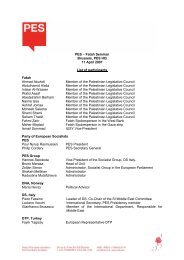Hedge funds and Private Equity - PES
Hedge funds and Private Equity - PES
Hedge funds and Private Equity - PES
You also want an ePaper? Increase the reach of your titles
YUMPU automatically turns print PDFs into web optimized ePapers that Google loves.
What is a fund of <strong>funds</strong>?<br />
The fund of <strong>funds</strong> is a structure for sharing investment across several private equity <strong>funds</strong>. The<br />
fund of <strong>funds</strong> is managed by a team of professionals offering investors the strategic construction<br />
of a diversified portfolio <strong>and</strong> the selection of management companies. These professionals<br />
manage the relationships with the various underlying <strong>funds</strong>, organize the review of valuations,<br />
transfer information <strong>and</strong> provide back office services for the <strong>funds</strong>.<br />
2.4 How they get the money<br />
How do LBOs organise the money for their activities? <strong>Equity</strong> financing for all the types of<br />
<strong>funds</strong>, including venture capital <strong>funds</strong>, typically involves the following steps:<br />
Launching a fund:<br />
First, a private equity company generally launches several independent <strong>funds</strong> in which<br />
investors’ capital is combined. The typical legal form of <strong>funds</strong> in Germany is a GmbH & Co.<br />
KG; in the UK <strong>and</strong> the United States they are limited partnerships. The investors do not take<br />
any management decisions themselves; the operational aspects of the business are<br />
combined in a separate company, frequently in the form of a general partnership. This<br />
company, in turn, is frequently controlled by a (fund) parent company of the private equity<br />
company, which performs a role comparable to that of a holding company. The advantage of<br />
having a fund with the legal form of a GmbH & Co. KG is that the liability of its capital<br />
providers (limited partners) is limited to the level of their capital contribution. This means that<br />
individual investors are not additionally liable for losses through their private assets.<br />
Acquisition of an investment in a business or purchase of a business division:<br />
In the second step the fund acquires the target business. Then they would typically use a<br />
blend of equity <strong>and</strong> borrowed capital to finance the purchase price, frequently at a ratio of<br />
30% equity to 70% borrowed capital.<br />
Restructuring, merging or splitting the acquired business:<br />
For some – typically venture <strong>funds</strong> – the aim here is to increase the value of the business by<br />
improving efficiency <strong>and</strong> productivity. But it can also mean that the sale of assets is made to<br />
provide cash to be paid out. Operating costs, e.g. through job cuts, are reduced mainly to<br />
increase cash flow. Cash flow may be used to borrow more debt in order to have cash for<br />
payments to the PE fund.<br />
Exiting the private equity company:<br />
In the final phase the investor attempts to sell his investment at a profit. The LBOs frequently<br />
do this via an IPO. It is now also common practice to sell to another investor (a so-called<br />
secondary buyout).<br />
2.5 <strong>Private</strong> equity is big <strong>and</strong> growing fast<br />
At worldwide level, the US market is still by far the most mature <strong>and</strong> developed <strong>and</strong> accounts<br />
for approximately 75% of the <strong>funds</strong> raised globally in the period 1983-2005 (€990bn).<br />
However, Europe accounts for a large part of the remaining private equity transactions. European<br />
<strong>funds</strong> in the same period (1983-2005) raised €350bn. 55% of the global total (€550bn)<br />
has been raised in the last 5 years, with Europe seeing a new surge in fundraising in 2005<br />
(€72bn) following a slow fundraising period from 2002 to 2004 (see chart below). The fundraising<br />
i.e. the investor contributions to the PE-<strong>funds</strong> must, of course, also be seen in relation to<br />
the real economy, the general macro-economic environment, the saving / consumption ratio etc.<br />
Part I – <strong>Hedge</strong> <strong>funds</strong> <strong>and</strong> private equity <strong>funds</strong> – how they work<br />
67




